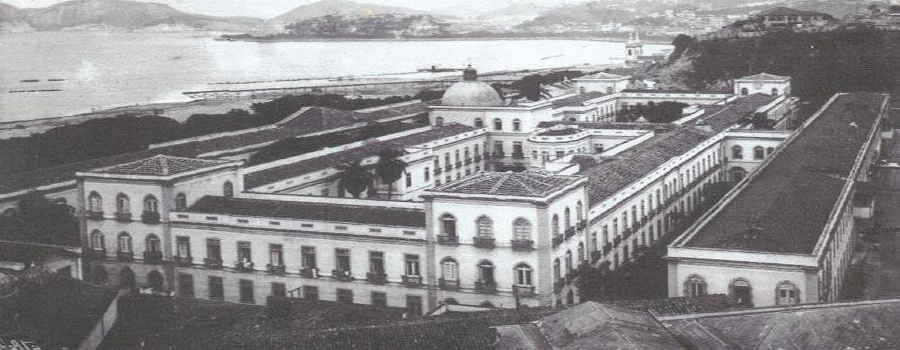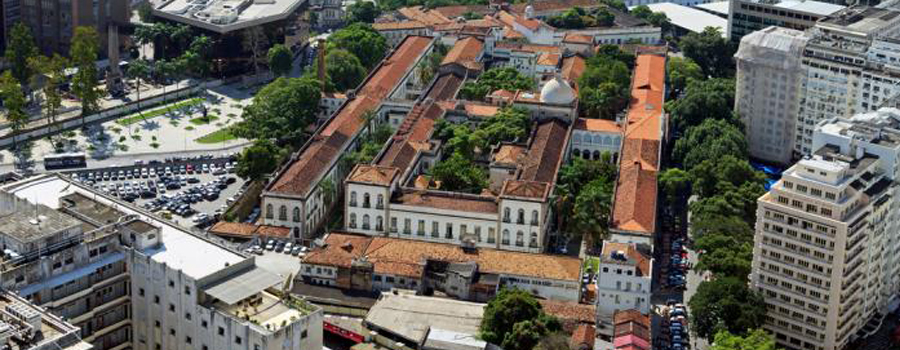General Hospital was the first establishment of the Santa Casa, founded by Anchieta in 1582. The squadron crew of the Spanish Admiral Diogo Flores Valdez was attacked by plague and an emergency docked in Rio de Janeiro. To address the sailors, Father José de Anchieta up a rough shack covered with straw. With herbs and berries, Anchieta managed to save most of the crew. And so began this great humanitarian work.
For many years the General Hospital was the only alternative to the needy people in the city. The Rio de Janeiro faced many alternate and even simultaneous pests, crowding the hospital. yellow fever, cholera, smallpox and bubonic fever attacked the population, in addition to the most common ailments and injuries generated by revolts and wars. The General Hospital saved many lives and minimized the suffering of many souls.
In the early years, the governors of the new colony became the providers of Mercy, responsible for the operation of the Hospital. With huge shortage of doctors, the hospital treated patients to base showers, benzeduras and herbs. Bleeding were common, and the deliveries were assisted by women gossips calls or curious in the homes of pregnant women.
Over the centuries, the General Hospital has undergone several renovations and expansion work, made according to the always scarce resources and according to the needs of each era. But without planning, the hospital was becoming a jumble of small buildings with poor air circulation and even underground floors subject floods. Despite the difficulties, the nosocômio provided uninterrupted service to the population since its founding.
In 1838 he was elected Ombudsman of the Holy House lawyer José Clemente Pereira. Great political and very influential at court, Catholic and poor protector, raised funds to initiate a makeover plan and expansion of the hospital.
The General Hospital was small and inadequate, insufficient to meet the city’s population growing. Moreover, it had no sewage or water for domestic service, nor separation between men and women. Under the Hospital worked a graveyard, unsanitary source.
The reforms started by the withdrawal of the cemetery, old claim of doctors. In 1840, after getting approval of a new location, Clemente Pereira inaugurated the Santo da Misericordia field in Cashew and sent close forever the tombs and catacombs beneath the hospital. Then laid the foundation stone of the new hospital, with the presence of Emperor Dom Pedro II.
All that can be availed from the old nosocômio was used to complete the new. Clemente Pereira inspected the work daily. To design and build the new hospital, they were called experienced engineers. The architecture and painting and sculpture works were performed by renowned artists at the time, in the neoclassical style. Noble materials were brought from Portugal.
The first stage of the work was completed in 1852 with large wards, clinics and offices with the capacity to serve up to three thousand patients a month. The first of the new hospital butler was José Maria Pereira de Lacerda.
Os melhores médicos trabalhavam no Hospital Geral, pioneiro em diversas práticas médicas. O clorofórmio, como anestésico, foi utilizado pela primeira vez no Brasil no Hospital Geral. Menos de um ano após sua introdução, por James Simpson na Inglaterra, o clorofórmio foi empregado como anestesia geral pelo Prof. Manuel Feliciano Pereira de Carvalho em 18 de fevereiro de 1848, sendo uma amputação da coxa em um rapaz de 15 anos de idade, por “tumor branco do joelho”.
No mesmo ano, foi fundada a Maternidade, atual 33ª Enfermaria. O uso da anestesia de clorofórmio foi adotado na Obstetrícia imediatamente. A partir de então o uso do clorofórmio se generalizou, suplantando o éter, até que novos agentes anestésicos foram descobertos e introduzidos na prática médica.
To improve and modernize the service in the new hospital, Clemente Pereira increased the clinical and nursing, renewed the practice, abolished privileges, created standards for the collection of care for those who could pay and isolated the sick with contagious diseases of others.
The Marques de Abrantes Hospital continued the project with the construction of the front body, the pillars of the central porch and the walkway. To meet all expenses, Marques managed by the government some aid in the form of fees and lotteries. Zacharias de Goes e Vasconcellos was 1866 Provider to 1877, completing the work begun by Clement Pereira. He finished the new facade, increased the number of beds, improved water supply and sewerage. Also took care of the maintenance, organizing the supply of foodstuffs.
From 1879 to 1883 José Ildefonso de Souza Ramos provider introduced the homeopathic treatment, treatment through hydrotherapy and electricity.
The next Ombudsman, John Mauricio Wanderley, Baron of Cotegipe created new wards and expanded services. also reformed the laundry. He was responsible for creating the Pasteur Institute, a pioneer in the prophylaxis against rabies in South America.
Always a pioneer, the Santa Casa was the first Brazilian hospital installing a disinfection machine through moist heat under pressure greenhouse, improving health. In the Ombudsman’s Cruzeiro do Visconde a gardening service was created done by the patients themselves, to take patients from the isolation of the wards.
Miguel de Carvalho provider dedicated 36 years to the House from 1902 until 1938. He gave great prominence to the General Hospital modernizing surgical appliances, meeting the proposal Butler Dr. José Carlos Rodrigues. Organized and drafted internal regulations and created the Temporary Asylum General Hospital, to receive the children orphaned by the death of pregnant women hospitalized there. In 1930 he built the Cynic Pavilion of Venereal Diseases in operation today.
Dr. Ary de Almeida e Silva took the Ombudsman and then installed Pavilion Paulo César de Andrade, the Clinical Analysis Laboratory, Clinical tumors, the roentgenphotography and Physiotherapy Services, the Bank of corneas, the Injectable Products Laboratory and the Institute of Anatomy and Pathology. In addition, it acquired new X-ray equipment, has carried out a general cleaning in the building and restored dozens of pictures and statues, preserving the art collection of the Hospital.
Elected his successor, Andrada Lafayette reshaped the file and created a library. Inaugurated new services in the Hospital Urology, Plastic Surgery, Blood Bank, Auxiliary School of Nursing, Cardiology, Neurology, among others. He held a series of reforms and improvements.
The Minister Afrânio Antonio da Costa was 1960 to 1977. Provider faced serious financial problems to the point of having to take an extreme measure: some services closed, leaving the population without the usual care. Before that emergency, there was a general mobilization and the Governor allowed the increase of the funeral tables to cover the expenses that swelled. Thus, the services were restored.
The Ombudsman unified Pharmacy with the Department of Industry Pharmaceuticals, reaparelhando the pharmaceutical industry.
The following providers were Eduardo Bahouth, followed by Dr. Paulo Niemeyer. They continued the work of his predecessor, always trying to modernize practices in the General Hospital and suit the new realities. With the financial problems always difficult actions were dedicated and relentless in defense of assisting the population. Dr. Zarur Dahas took over in 2004 the Ombudsman and has been working diligently to maintain current services of the Hospital, despite financial difficulties. In this fit the appointment of the current head of the 28th ward, Professor of Gynecology Service Silvio Silva Fernandes.


